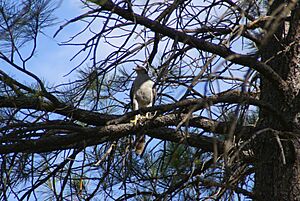American goshawk facts for kids
Quick facts for kids American goshawk |
|
|---|---|
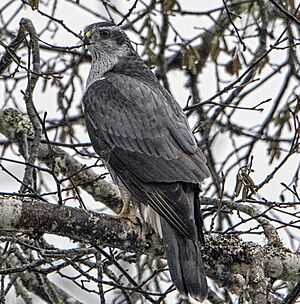 |
|
| Adult in Juneau, Alaska | |
| Conservation status | |
| Scientific classification | |
| Genus: |
Astur
|
| Species: |
atricapillus
|
| Subspecies | |
|
|
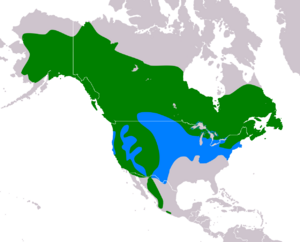 |
|
| Range of A. atricapillus Resident Non-breeding | |
The American Goshawk (scientific name: Astur atricapillus) is a powerful bird of prey that belongs to the Accipitridae family. It was first officially described by Alexander Wilson in 1812. Until recently, people thought the American Goshawk was the same species as the Eurasian Goshawk. However, in 2023, scientists decided they were different species. This decision was based on how they look, the sounds they make, and their DNA. These birds usually stay in one place all year. But goshawks living in very cold areas will fly south for the winter to find warmer places and more food. In North America, you might see them flying along mountain ridges during the autumn as they head south.
Contents
Where Goshawks Live
American Goshawks live across a large part of North America. You can find them mostly in the Western United States, including Alaska, and in western Canada. They build their nests in the wooded hills of the Rocky Mountains and other big mountain ranges. Their territory stretches from Washington State all the way down to southern California. It also goes east to central Colorado and parts of Texas.
You can also find smaller groups of goshawks in southeastern Arizona and southwestern New Mexico. From there, they spread into western Mexico, through states like Sonora and Chihuahua. They follow the Sierra Madre Occidental mountains as far south as Jalisco and Guerrero. This is the southernmost place where they raise their young.
Goshawks also live across much of Canada. However, they are less common in the Eastern United States, especially in the Midwest. Here, you'll mostly find them around the Great Lakes region. There are good numbers in northern Minnesota, Illinois, Michigan, and parts of Ohio. A tiny group also lives in the very northeast corner of North Dakota. They also nest in the mountains of New England, New York, central Pennsylvania, and northwestern New Jersey. Sometimes, they are seen as far south as northwestern Maryland and northeastern West Virginia.
Goshawk Homes: Forests and Habitats
American Goshawks live in many kinds of forests. This includes deciduous forests, which have trees that lose their leaves in autumn, and coniferous forests, which have evergreen trees like pines. The type of tree isn't as important as the forest's structure. Goshawks prefer tall, old forests with a thick tree canopy (more than 40% cover). They also like areas with not too much undergrowth, which helps them hunt.
They often choose spots close to open areas where they can hunt more easily. While they don't always need to be near water or riparian zones (areas along rivers), it's common to find them there. In winter, narrow strips of trees along waterways can be good homes if larger forests aren't available.
Goshawks can live at almost any height, from lowlands to high mountains. However, because many lowland forests have been cut down, they are now more often found in high mountain areas. They can live up to the tree line of a mountain, which is usually around 3,000 meters (about 9,800 feet) high. In winter, goshawks from the coldest northern or high mountain regions fly down to warmer, lower forests. Most goshawks, however, stay in the same area all year long.
What Does a Goshawk Look Like?
Young goshawks can sometimes look confusingly similar to other young Astur species. Adult American and Eurasian Goshawks never have a rusty color on their bellies. Their wing beats are deep, slow, and strong.
Spotting Similar Birds
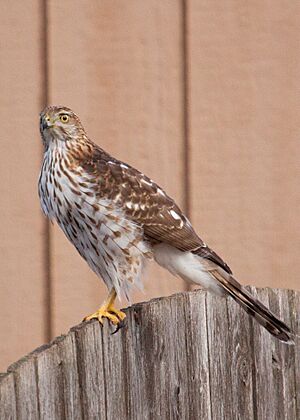
Sometimes, people mistake American Goshawks for other birds, especially when they are young. In North America, some types of buteonine hawks might look similar. These hawks are usually smaller than goshawks. They also have longer wings and shorter tails compared to their body size.
One bird, the Gray Hawk (Buteo plagiatus), is sometimes called the "Mexican goshawk." Young Gray Hawks have dark eye-stripes, dark eyes, and barred thighs. They also have a white "U" shape on their upper tail feathers. The Roadside Hawk (Rupornis magnirostris) is much smaller with unique paddle-shaped wings.
Young goshawks are also often confused with the smaller Cooper's Hawk (Astur cooperii). Young goshawks have strong, vertical streaks on their chest and belly. Young Cooper's Hawks often have streaks that look like "teardrops," tapering at the top. Goshawks also tend to have a shorter tail compared to their wider body. Even though a small male goshawk might seem similar in size to a large female Cooper's Hawk, their wing and tail measurements are actually quite different.
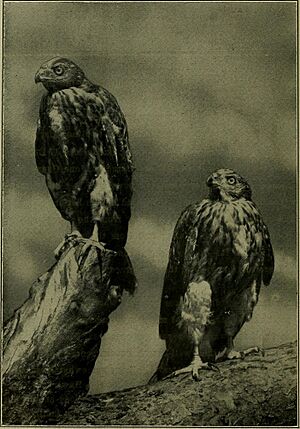
Goshawk Family Tree
The Astur group of birds includes nine living species. These are quick, forest-dwelling hawks that have been around for millions of years. They likely evolved to hunt the many small birds that live in forests.
The American Goshawk is part of a larger group of goshawks found around the world. The Eurasian Goshawk, which lives in Eurasia, was once thought to be the same species. Scientists now know they are distinct. The Meyer's Goshawk, found in the South Pacific, is believed to be a close relative.
Genetic studies show that the Cooper's Hawk of North America is also related to the American Goshawk. The much smaller Sharp-shinned Hawk is also found in North America.
Different Kinds of American Goshawks
There are three main types, or subspecies, of American Goshawks:
- A. a. atricapillus (Wilson, 1812) – This is the most common type across North America, except for some islands and the southern Southwest. These goshawks are usually a bit smaller than Eurasian ones. Males weigh from 655 to 1,200 grams (about 1.4 to 2.6 pounds), and females from 758 to 1,562 grams (about 1.7 to 3.4 pounds). They are typically blue-gray on top with a black head and white stripes above their eyes. Their undersides are grayish with fine gray bars. From a distance, they can look completely gray, earning them the nickname "gray ghost."
- A. a. laingi Tavernier, 1940 – This type lives on islands like Haida Gwaii and Vancouver Island. They are slightly smaller than the mainland goshawks. These birds are darker than other American goshawks, with black feathers extending from their crown to their shoulders. Their undersides are a sooty gray.
- A. a. apache (van Rossem, 1938) – You can find this type from southern Arizona and New Mexico all the way through Mexico. These goshawks have the longest wings of all the American subspecies. Males weigh about 631 to 744 grams (about 1.4 to 1.6 pounds), and females from 845 to 1,265 grams (about 1.8 to 2.8 pounds). They are also darker than most other American goshawks, similar to the laingi type.
Goshawk Habits: How They Live
Goshawk Journeys: Migration
Some American Goshawks migrate south for the winter. They might travel as far as Baja California, Sinaloa, and parts of west Texas. However, in most years, they don't go further south than states like Nebraska, Iowa, Illinois, and Indiana. Sometimes, they have "irruptive movements," meaning many birds suddenly move much farther south, even close to the Gulf of Mexico. This happens about every 10 years.
The amount of food available often decides how many goshawks migrate and where they go. If there's less prey, more birds will move. Snow can help them catch prey at first, but too much snow can make it harder to find food. Young male goshawks tend to travel farther than young females, which is unusual for birds of prey.
What Goshawks Eat
Hunting Skills
American Goshawks are skilled hunters. They are "opportunistic predators," meaning they will hunt whatever food is easiest to find. They mainly hunt small to medium-sized mammals and medium to large-sized birds. They hunt in forests, at the edges of forests, and in bushy areas.
Favorite Foods
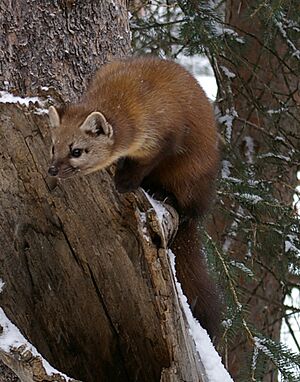
Some of their most important prey include corvids (like jays and crows), pigeons, grouse, pheasants, thrushes, and woodpeckers. Among mammals, they often eat squirrels (especially tree squirrels) and rabbits and hares. Birds make up about half of their diet, and mammals make up the other half.
- Squirrels: Tree squirrels are a very important food source. The American Red Squirrel (Tamiasciurus hudsonicus), weighing about 240 grams (8.5 ounces), is a primary food in many areas, from the eastern United States to Alaska. In the Pacific Northwest, the Douglas Squirrel (Tamiasciurus douglasii) is a key prey. Goshawks also hunt larger squirrels like Eastern Gray Squirrels (Sciurus carolinensis) and Fox Squirrels (Sciurus niger). Ground squirrels are also important, especially in North America. They can even attack much bigger ground squirrels like marmots, especially young or weaker ones.
- Hares and Rabbits: Mammals like snowshoe hares (Lepus americanus) are a major food source, especially in Oregon and Alberta. These hares can weigh about 1,500 grams (3.3 pounds). Eastern Cottontails (Sylvilagus floridanus), also weighing around 1,500 grams, are important prey in places like Arizona. Goshawks can even take larger hares like the Black-tailed Jackrabbit (Lepus californicus).
- Gamebirds: American Goshawks are known for hunting gamebirds, especially grouse. They hunt many species of grouse, which are often found on the ground. If a gamebird is surprised, it might run instead of flying, making it easier for the goshawk to catch. Young gamebirds are especially vulnerable.
- Corvids: Birds like jays and crows are common prey. The Steller's Jay (Cyanocitta stelleri), weighing about 128 grams (4.5 ounces), is a main prey in some areas. Even large birds like the American Crow (Corvus brachyrhynchos) are hunted.
- Woodpeckers: Woodpeckers, such as the Northern Flicker (Colaptes auratus), are often caught by goshawks. Their relatively slow, wavy flight makes them easy targets. Goshawks hunt woodpeckers of all sizes, from the tiny Downy Woodpecker (Picoides pubescens) to the large Pileated Woodpecker (Dryocopus pileatus).
Goshawks and Other Animals
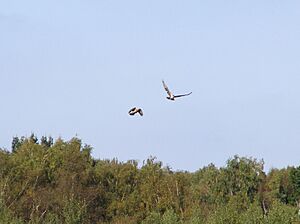
American Goshawks are often at the top of the food chain in their forest homes. They compete for food with other predators, especially where they hunt many rabbits and hares. When the populations of these prey animals go down, goshawks can also be affected. However, goshawks are not picky eaters and can switch to other foods like squirrels and woodland birds. This helps them survive even when their favorite prey is scarce.
Goshawks are very fast and agile. They have strong feet and a powerful attack. They can even hunt other birds of prey, including smaller hawks like the Sharp-shinned Hawk and the Cooper's Hawk. They have also been known to kill larger hawks like the Red-tailed Hawk. Goshawks can also pose a threat to young osprey chicks.
Protecting Goshawks
The American Goshawk lives across a huge area in North America, covering over 30 million square kilometers (about 11.5 million square miles). There are an estimated 150,000 to 300,000 goshawks in North America. Globally, the population of American and Eurasian Goshawks combined is thought to be between 1 million and 2.5 million birds.
In the past, goshawk populations decreased in some areas because people hunted them or disturbed their habitats. For example, in the 1930s, some states even paid money to people who killed goshawks.
Later, in the 1950s and 1960s, pesticides (chemicals used to kill pests) caused problems for many birds, including goshawks. However, by the early 1970s, pesticide levels in goshawks in the United States were low.
Today, the biggest threat to goshawks is deforestation, which is when forests are cut down. When too many trees are removed, especially old, tall trees, goshawks may leave the area. Noisy activities like logging can also disturb nesting goshawks, causing them to abandon their nests.
In North America, the American Goshawk is protected by laws like the Migratory Bird Treaty Act of 1918. The United States Forest Service also lists the goshawk as a "sensitive species," meaning it needs special care. These protections help ensure that these amazing birds continue to thrive in our forests.
Images for kids
-
Woodpeckers such as Northern Flickers often fall victim to goshawks.



